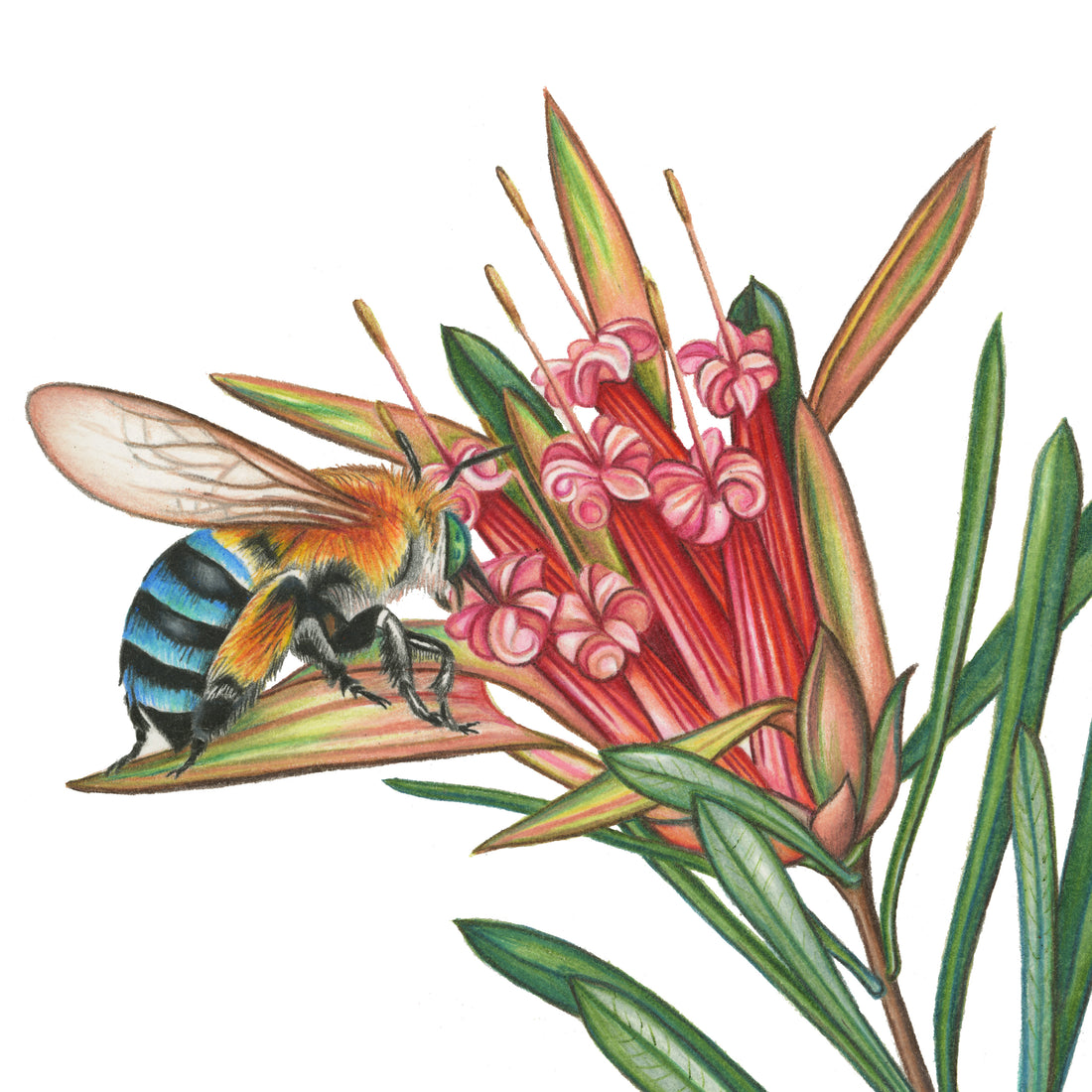
Blue-banded bees (Amegilla cingulata) on a mountain devil (Lambertia formosa). Illustration by Rachel Diaz-Bastin.
Honeybees get a lot of buzz, but what about nature’s bigger buzzers? Those adorably-awkward bumbling bees that spend their days bumping into flowers. They are fuzzy, they are loud, and they are often joyfully colorful. The blue-banded bee from Australia is no exception. In fact, I dare you to find a more magical-looking bee!

Blue-banded bee (Amegilla cingulata). Photo by Srikaanth Sekar.
But there is more to the blue-banded bee than resplendent blue butts.
Blue-banded bees aren’t technically bumblebees (bumblebees belong to the genus Bombus, while blue-banded bees belong to the genus Amegilla), but these furry flyers share some common traits. Notably, both blue-banded bees and bumblebees have the ability to shake pollen out of flowers using a technique called “buzz pollination”.
Buzz pollination (also called sonication), is a feat of strength and endurance that honeybees just can’t match, and it is critical to the 20,000 or so species of plants that depend on it for reproduction.
Flowers that have evolved buzz pollination are unique. They don’t simply put their protein-rich pollen out like cookies on a table for any Tom, Dick, or hairy insect to eat. Making pollen takes time and energy! So these flowers keep it tucked inside tubular stamens that few but the biggest bees are able to access.
To accomplish this a bee will typically grab a stamen with its jaws and vibrate its flight muscles hundreds of times a second. It has to hold on tight though, otherwise the vibrations could send it flying off the flower! Bees experience some totally tubular forces 30 times greater than gravity as they buzz for pollen. That’s near the limit of human endurance, and definitely more than Taylor Swift has ever accomplished, even in her most shakiest offiest of days.
Take a look at this video!
Some plants, like corn, ragweed, and oak trees, cast their pollen to the wind in order to reproduce. Others depend on pollinators like bats, birds, butterflies, and bees to act as their personal pollen distributors. Many flowers use nectar as a lure, and advertise widely to insects and birds to come and eat. But flowers that depend on buzz pollination are looking to attract very specific bees and insects, a relationship that was shaped over the course of evolution. Over time, as their pollen became more difficult to access, natural selection favored bigger bees that could shake their flowers harder.
Many of our important crops evolved in this way, such as cranberries, tomatoes, potatoes, and eggplants.
That’s why big bees are so agriculturally important. Take Australia as an example. While surprisingly not the birthplace of Koala Yummies, Australia also sadly does not have any native bumblebees. For that reason greenhouse-grown tomatoes there are currently hand-pollinated using an “electric bee” (basically a tuning fork that releases pollen via vibrations in a similar way to bees).
As this Simpsons clip explains, that could spell ecological disaster.
Not to fear, though, because it turns out there is a better solution right in Australia’s backyard: the native blue-banded bee! Hard to imagine that these Aussie stunners were ever overlooked in the first place, but recent research has shown that they are quite successful in pollinating greenhouse tomatoes, thank you very much. In fact, they may even be better at it than bumblebees!
Bumblebees use their flight muscles to shake pollen out of flower anthers, but it turns out that blue-banded bees use a technique that’s infinitely more hardcore, but familiar to metal fans: headbanging. With a headbanging rate of 350 times per second – which could put even the most die-hard metal fans to shame – blue-banded bees can shake flowers at a greater frequency than bumblebees.
Did I mention they are cute too?

Female blue-banded bee. Photo by James Niland.
What a win-win! And a reminder of how important jumbo bees are, wherever they are found.
So the next time you hear a big ol’ bee buzzing furiously on a flower, you will know that they aren’t having a panic-attack, they are carrying on a long and glorious tradition of shaking out their pollen snacks, and in the process, ensuring the survival of thousands of plants, many of which we know and love.
(Repost): Original Post: https://thebefuddledloris.wordpress.com/2016/09/19/what-all-the-buzz-is-about/
